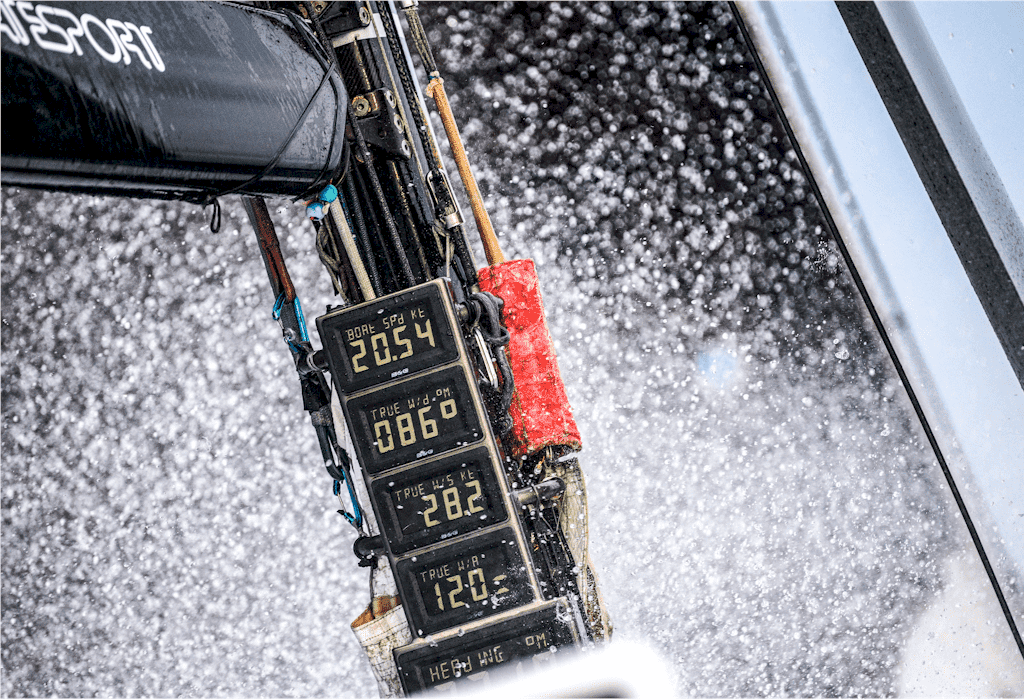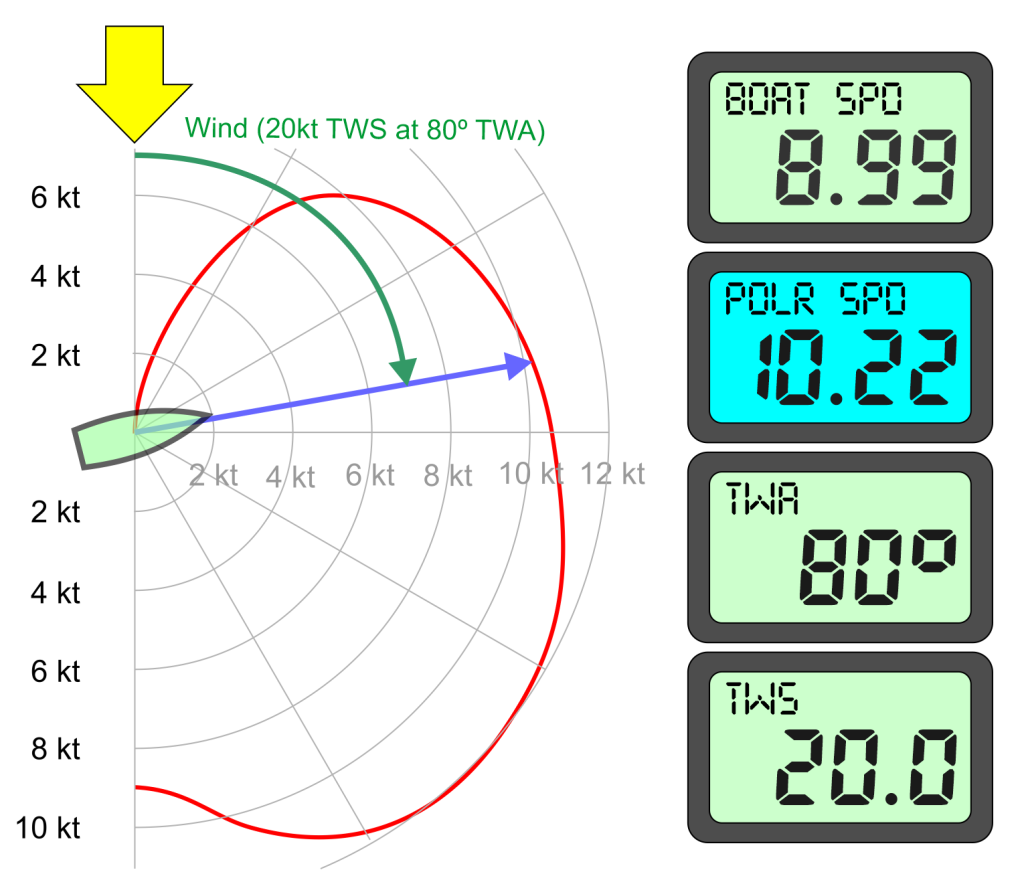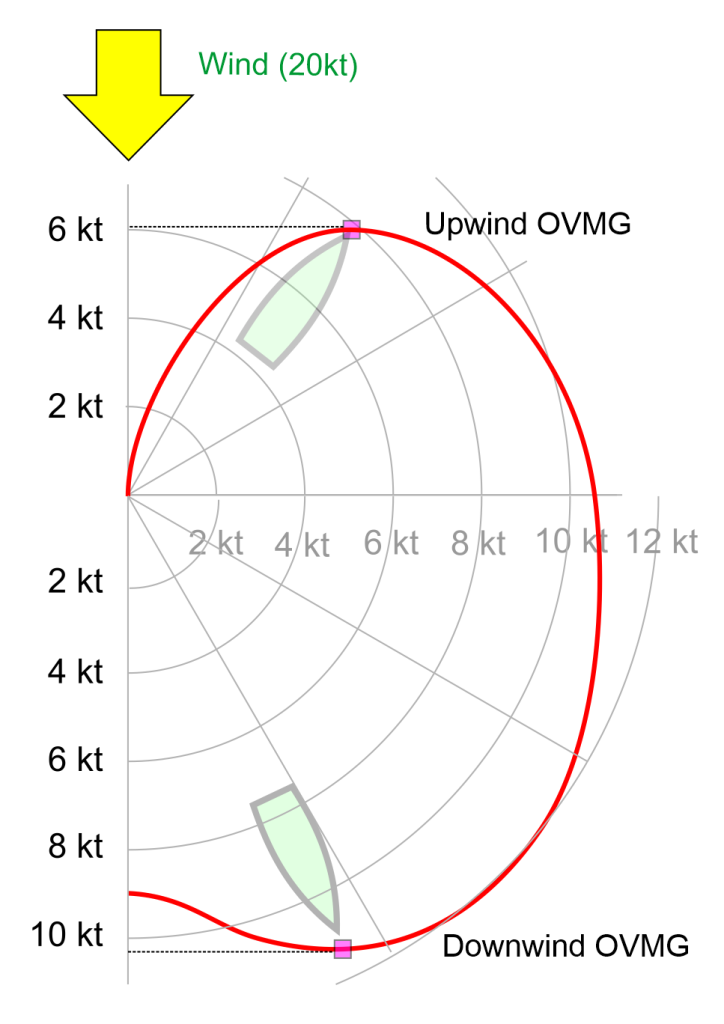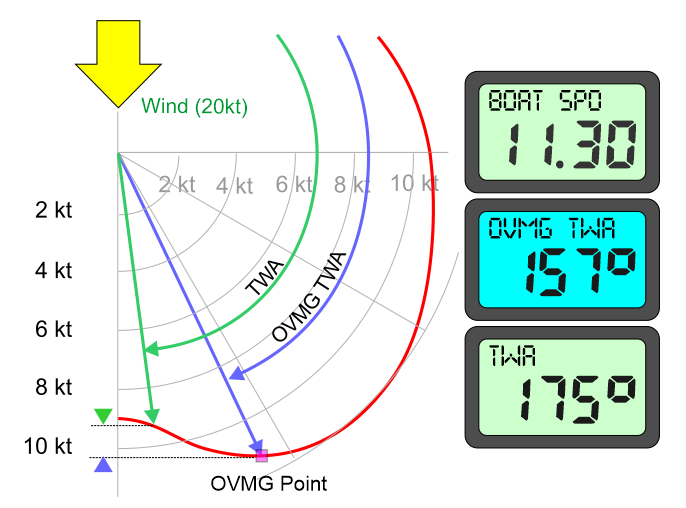Understanding boat polar curves is crucial for their practical application in racing. We will start with Polar Curves for Performance. If you still have doubts about polar curves, please refer to this article.
Performance
As this article discusses performance, it’s essential to clarify that in sailing, ‘performance’ is not just a term but a crucial factor that determines the boat’s ability to sail efficiently and effectively in different wind conditions. It’s a concept that can significantly impact the outcome of a race.
When sailing in performance mode, you do so without a set destination, and your only point of reference is the boat’s angle to the wind or True Wind Angle (TWA). You certainly don’t care about coordinates, directions, or headings. We never consider the COG, SOG, or current when talking about performance sailing!
This is the domain of the helmsperson, the trimmers, and the foredeck team. They are responsible for steering, boat handling, selecting sails, trimming, and flawless maneuvers. Their focus is on keeping the boat at top performance. Performance sailing is useful for crew training and sail testing. But while racing, it complements tactical sailing, where tacticians decide how to sail from one place to another in the shortest possible time. So, when training on performance, feel free to give the navigator and tactician the day off!
Undoubtedly, your crew is the backbone of your boat’s performance in all wind conditions; their role is essential and integral to the sailing experience. They often rely on the boat’s speed to indicate their success. But here’s the challenge: when sailing at a given TWA and with a True Wind Speed (TWS), how do they know the best possible performance? And when tacking upwind or gybing downwind, how do you know if they are achieving the optimum Velocity Made Good (VMG)?
Performance Targets
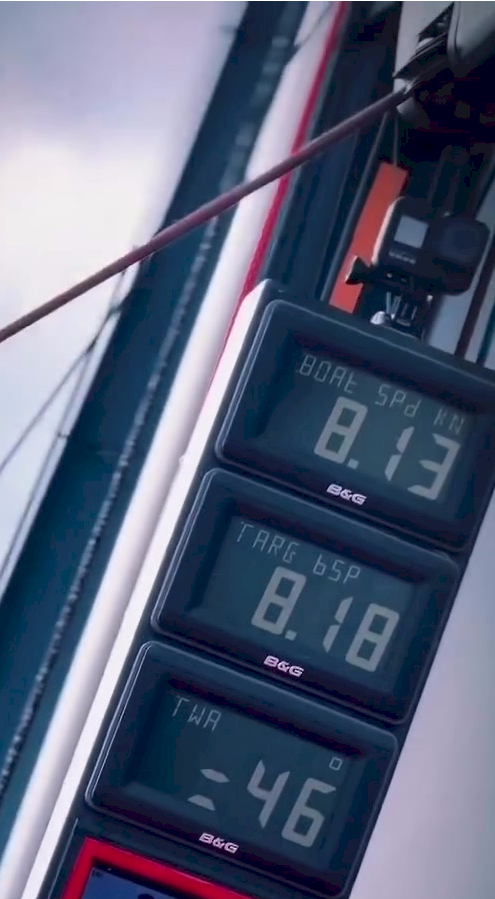
As you might expect, polar curves provide the answer. Here are some key points and how this works.
- EVOLUTION continuously receives the TWA and TWS from the instruments and looks at the boat’s polar curves to obtain the ideal performance targets.
- On EVOLUTION, you must specify the target you prefer to view. More on these below.
- The system then sends these targets back to the instruments to be displayed on the mast.
- The crew can now compare actual performance with ideal targets. They will make the necessary adjustments to reach the best-expected performance.
You must set up a display on the mast to show the data that EVOLUTION sends back. The specific way to do this depends on your instrument system. More details about this topic can be found at the end of this article. For now, let’s assume that you have configured the displays to show, on top, the boat speed; on the second display, the targets sent by EVOLUTION; on the third display, the TWA; and optionally, the TWS on the fourth display.
This is all you need for performance sailing! Now, let’s see these targets and how to use them to your advantage.
Polar Speed Target - POLR SPD
Polar speed target is the most straightforward performance indicator.
Sailing in a given TWA under a persistent wind speed, EVOLUTION can send the ideal speed at which the boat should sail in those conditions to any display (usually the selected one on the mast).
In the following example, let’s assume a constant TWA of 80 degrees and a TWS of 20 knots. The boat speed stabilizes at 8.99 knots.
EVOLUTION uses this TWA and TWS on the boat’s polar curves and calculates a target boat speed of 10.22 knots. It then sends this value to the instrument’s system to be displayed on the second display. The following diagram illustrates the calculation process, and the display column shows what your crew should see.
It’s easy to notice if the boat is moving slower by more than a knot, prompting the crew to quickly adjust the sails or address any issues affecting the boat’s performance.
The benefits are subtle but important:
- You will always have a reference to take action to improve the performance of the boat, and
- With a clear target, your crew will be attentive and focused, leaving subjective and unproductive discussions aside.
Optimal VMG
VMG stands for Velocity Made Good. In sailing, it’s a crucial concept, especially in racing, that measures how fast a sailboat is progressing towards (or away from) the direction of the wind.
Please do not confuse this VMG with the GPS “VMG” to some waypoint. We are in the Performance World, with no GPSs and no waypoints.
VMG isn’t just about speed. While boat speed is essential, the VMG also considers the angle to the wind (TWA). When you sail against the wind, you progress by tacking directly against the wind. While sailing downwind, most boats achieve better VMG at true wind angles smaller than 180 degrees, gybing instead of tacking.
Analyzing the polar curves for a given TWS in the following image reveals the optimal conditions for sailing upwind and downwind. In EVOLUTION, these conditions are called optimal VMG or OVMG targets.
The challenge is finding the TWA at which the boat achieves upwind and downwind OVMG. This will give you the targets for boat speed and TWA to help your performance crew do their best when racing, especially in windward-leeward race courses.
Both OVMG points have two targets: true wind angle and boat speed. The polar curve for the prevailing wind speed yields the values targets. Below, we will see how EVOLUTION will help you maintain optimal VMG upwind and downwind.
Optimum VMG Target - OVMG SPD
To sail upwind at optimum VMG, we could match the OVMG TWA target with the actual TWA. However, obtaining an accurate boat’s TWA is difficult due to challenges with calibrating the wind sensor and the common issue of wind shear. Instead, matching the OVMG boat speed target against the boat’s speed will always be more reliable.
In the graphic, the instruments show the boat speed as 8.67 kt on the first display. At the same time, EVOLUTION calculates an upwind OVMG SPD of 7.95 kt based on the TWS 20 kt polar curve and sends it to the second display. This makes sense as the boat is sailing at a TWA beyond the OVMG TWA.

To sail at optimum VMG, the helmsperson and trimmers should sail closer to the wind until the OVMG and actual boat speeds are as similar as possible. If the actual speed gets below the OVMG speed, they must bear away slowly until both speeds are alike.
The actual boat speed in the image is 6.92 knots, and EVOLUTION suggests an OVMG speed target of 6.90 knots. The crew is doing great, sailing right at the OVMG spot and performing at their best while sailing upwind.
The basic rule is if the boat speed is lower than the OVMG speed target, bear away; if it is higher than the target, head up. Slowly!
Optimum VMG Target - OVMG TWA
When sailing downwind, to achieve optimum VMG, you should match the OVMG TWA target with the actual TWA. Although the actual TWA is affected by calibration and occasional shear wind issues, matching the OVMG TWA target against the boat’s TWA will be easy and reliable.
In the graphic, the instruments show the actual TWA being 175º on the third display. At the same time, EVOLUTION calculates a downwind OVMG TWA target of 157º kt based on the TWS 20 kt polar curve and sends it to the second display.
You can configure EVOLUTION to switch data items on a single display depending on the sailing mode; this is done automatically.
Optionally, two data items can alternate every 3 seconds on the same display. For example, you could show the OVMG TWA and the OVMG SPD on the second display, helping the crew with a speed reference.
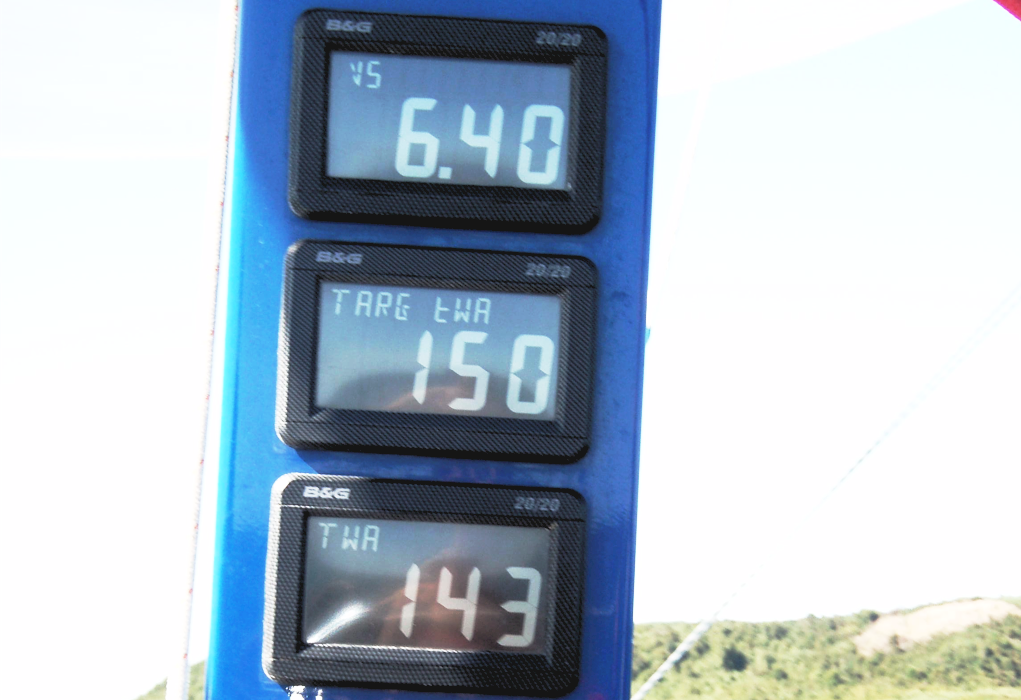
To sail at optimum VMG downwind, the helmsperson keeps the boat’s TWA as close as possible to the OVMG TWA, and trimmers work on the sails to keep the boat at its best speed. Matching TWA should be no problem with the target and actual values on sight.
The actual TWA in the image is 143º, and EVOLUTION suggests an OVMG TWA target of 150º knots. In response, the helmsperson should bear away a few degrees, and the crew should trim accordingly.
The basic rule is simple: steer the boat so the actual and target TWA are as close as possible, then let the trimmers do their job. In other words, don’t adjust the sails by steering.
Under the Hood
Evolution only requires the current true wind (TW) to calculate the performance target. It utilizes a 10-second moving average of the TW and then calculates the targets using the boat’s polar curves. This effectively dampens the targets to adjust for the boat’s inertia when accelerating or decelerating. This approach improves your ability to match real boat speed and TWA to the target values.
The system interpolates the polar curves to create a new “virtual” curve for the precise TWS every second. It then scans this curve for the upwind and downwind OVMG targets and, using the real TWA, obtains the polar speed target.
Wraping Up
The frame of reference for performance numbers is the water—not the ground. Performance data only refers to the boat’s motion through the water. All values are symmetrical to the wind, so only half of the polar diagram is used.
There are only a few main Performance Sailing data items: real TWA, TWS, and BOAT SPD; then the targets POLR SPD, OVMG SPD, and OVMG TWA. Another pair of helpful data items is the HEEL and the HEEL target, plus the expected leeway angle LWYA, which is a topic for another article.
The Mantras for Your Performance Crew
“Upwind: Match the boat speed to the OVMG SPD.”
“Downwind: Match the TWA to the OVMG TWA.”
“Reaching: Match the boat speed and the POLR SPD.

